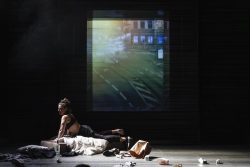 THE Girl on the Train was one of the best-selling novels of all time, topping the fiction lists in both the UK and the US for months. Paula Hawkins’ thriller was successfully adapted into a hugely successful film, starring Emily Blunt, and now comes to Salisbury Playhouse in a brilliantly visualised, minimalist staging that brings out the psychological complexities of the story.
THE Girl on the Train was one of the best-selling novels of all time, topping the fiction lists in both the UK and the US for months. Paula Hawkins’ thriller was successfully adapted into a hugely successful film, starring Emily Blunt, and now comes to Salisbury Playhouse in a brilliantly visualised, minimalist staging that brings out the psychological complexities of the story.
In the book you follow the story through the eyes and words of three women – divorced alcoholic Rachel, new mum Anna, married to Rachel’s former husband, and Megan, an art gallery owner and sometime nanny for Anna’s baby.
In the play, the story is seen largely through Rachel’s eyes – and as a drunk, living a chaotic life in an untidy bedsit, watching other people’s apparently happy lives, she is a very unreliable narrator.
Every day Rachel takes the train to work, passing her old house and two doors along, the home of a young couple about whom Rachel weaves a picture of true love. So when one day she sees the wife in the arms of another man, she is shocked.
Her reaction to any change or challenge is to reach for a bottle. She is so drunk that one day she wakes up with a bad cut to her head, a lot of empty bottles and no idea how she was injured.
 When a detective comes to see her to talk about a missing woman – Megan, Rachel realises she is the woman she has been watching. Her imagination is fired up, and over the next few days she visits the missing woman’s home and pretends to the husband that they were friends.
When a detective comes to see her to talk about a missing woman – Megan, Rachel realises she is the woman she has been watching. Her imagination is fired up, and over the next few days she visits the missing woman’s home and pretends to the husband that they were friends.
As she pursues her private investigations, spinning more stories as she goes, she is drawn further into the reality of Megan’s life. When the missing woman is found dead in an underpass, Rachel gradually begins to realise that something happened there that she cannot remember – and she must recapture this missing memory.
The stage is bare, with minimal props – a mattress, chairs and a table – carried on and off as needed. At the back is a large screen, that is by turns a station platform and the train window through which Rachel sees passing trains and glimpses people in their houses; it is also the gallery where Megan displays huge abstract canvases that her husband cannot understand, and at one point it becomes a slowly revolving box in which Rachel is tumbled.
This stripped-down approach means it’s all about the words and the acting, the interaction of Rachel with her ex-husband, his new wife, the detective, Megan’s husband, and Megan’s therapist. The psychological aspects of the story are absolutely central and the audience is led along a tortuous route, via Rachel’s increasingly frantic efforts to get to the truth and to recover the memory of what really happened that night.
 It’s a dark and disturbing tale, with gaslighting at its heart, a story of loss and grief and guilt.
It’s a dark and disturbing tale, with gaslighting at its heart, a story of loss and grief and guilt.
Joanna van Kampen, who plays Rachel and is on stage almost all the time, says she is drawn to vulnerability and messiness, to characters who have hit rock bottom. Rachel is deeply flawed, she says, and she makes questionable choices, but “there has to be enough there to make you want to be with her for the journey.”
Last seen at the Playhouse in the Ayckbourn comedy How The Other Half Loves, Joanna – best known as Fallon Rogers in The Archers – here shows her impressive grasp of a damaged character. She succeeds in making us care about Rachel, even while shuddering at the squalor of her life.
She is well supported by Jason Merrells as an intelligent and oddly sympathetic detective, Emer McDaid as Megan Hipwell, Samuel Collings as Scott Hipwell, Tiran Aakel as Kamal Abdic, the therapist, Jonathan Firth as Tom Watson and Phoebe Pryce as his second wife, Anna.
Adapters Rachel Wagstaff and Duncan Abel have taken Paula Hawkins’ original story and remade it as a powerful piece of theatre, stripped of description and comment. One woman has to speak for three, all revealed as victims in different ways. Director Loveday Ingram brings a probing empathy to the story, emphasising how little agency these women have, while using the film and noise of high-speed trains and the physical chaos of the crowded station platforms to convey the confusion of imagination, anger and lost memory in Rachel’s drink-befuddled brain.
FAC
Photographs by Ellie Kurttz.